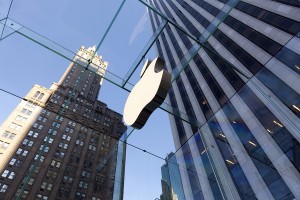After nearly a year topping $500 a share, Apple Inc. (NASDAQ:AAPL)’s stock is down 30 percent from its peak—September, when it exceeded $700—and fell to $484 Jan. 15 before slightly rebounding the next day. Was 2012 a sole year of glory for Cupertino? Right now it’s anyone’s guess. As Business Insider’s Henry Blodget recently wrote, “Stock prices are based on what people think will happen in the future, not what has happened in the past. And no one knows what will happen in the future.”
But what could happen? Let’s review the facts.
Back to the future
If Apple doesn’t get on board with a less-expensive smartphone—ie. the rumored “cheaper iPhone—it will lose out in emerging markets, slowing the company’s growth. Likewise, Apple (AAPL) is set to lose tablet market share, as its competition is introducing more devices similar to the iPad. Even if Apple delves into the lower-end smartphone and tablet market, its profit margin will shrink compared to today’s iPhone and iPad.
So, thus far we have either smaller market share or smaller profit margin. Neither spells disaster for Cupertino, but neither sends Apple (AAPL) stock back to $700-plus a share, either.
Even though stock prices are based on forecasted future performance, we can learn from history, and Apple may already be repeating some of its own. As Fortune tells it, Apple is repeating a mistake it make in the 1980s by making it difficult for developers and peripheral-makers to design associated products.
Closed For Business
 Remember the war between Apple and IBM (NYSE:IBM) in the 1980s? Apple (AAPL) operated on an extremely closed business model with its MacIntosh computer, and didn’t allow other computer manufacturers to use its OS or copy its parts. IBM (NYSE:IBM), on the other hand was very open in allowing other manufacturers to access the Windows platform and PC-compatible hardware. Mac may have been the Rolls Royce of personal computers, but PCs were more practical and became the choice of modern families.
Remember the war between Apple and IBM (NYSE:IBM) in the 1980s? Apple (AAPL) operated on an extremely closed business model with its MacIntosh computer, and didn’t allow other computer manufacturers to use its OS or copy its parts. IBM (NYSE:IBM), on the other hand was very open in allowing other manufacturers to access the Windows platform and PC-compatible hardware. Mac may have been the Rolls Royce of personal computers, but PCs were more practical and became the choice of modern families.
Fast forward to the 2013 and Apple is once again making business difficult for its partners. Although more than 500 Apple peripheral products were on display at the 2013 Consumer Electronics Show in Las Vegas, not a single product was compatible with the new Lightning 8-pin adapter—even though the technology was released in September. According to Fortune, the delay in peripheral products can be blamed on Apple’s tight lock on the testing process.
Apple (AAPL) still holds a tight grip on its software, as well. App designers AppStreet Boys told Fortune it took them a full year to get Apple’s approval to release “Guess Dat Song.” Many other developers at the CES expressed similar frustrations with Apple’s “testing” process. As more developers cater specifically to Google’s open Android system, Apple may want to take a lesson from its own history book.
To the rescue
As the iPhone celebrates its sixth birthday, is it time for Apple (AAPL) to unveil the next big thing and stop relying on the once-revolutionary smartphone to invigorate its sales every year? For the past two product launches, sales have steadily declined following an initial burst at the starting line. First-quarter iPhone 5 sales are predicted to hit 40 million units—nothing to sneeze about—but that success actually equates a 16-percent drop from the just-ended fourth quarter. Has the iPhone gotten too long in the tooth?
Many analysts expect the release of the iPhone 5s to occur in either June or July. But will an incremental release excite consumers enough to boost sales? After all, other than the addition of Siri and a speed chip, very little changed from the 4 and the 4s. How many times will consumers rush out to buy a somewhat different version of the phone they already have. Do we really expect people to one day clamor to purchase an iPhone 13s?
Perhaps Apple would be better advised to change gears and enter a new market. Perhaps the long-rumored Apple (NASDAQ:AAPL) TV? Interestingly enough, Global Equities Research analyst Tim Chowdry believes Apple’s recent change in LCD suppliers indicates the mythical TV is certainly in the pipeline for 2013. According to Chowdry, Apple (AAPL) is changing to a new display technology called Indium Gallium Zinc Oxide which happens to be perfect HDTV and other large screens since it displays faster. It’s also pliable.
“It could make a flexible device you can put in your pocket,” he told MarketWatch.



